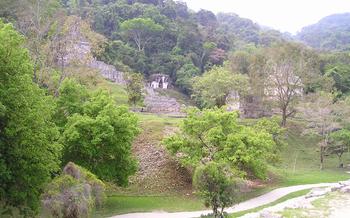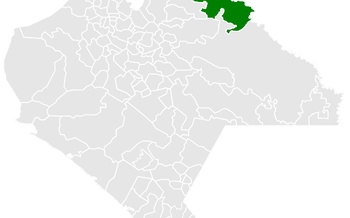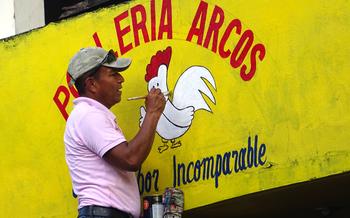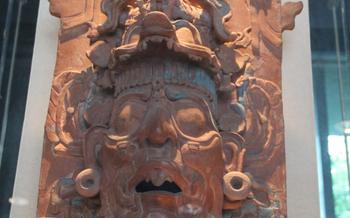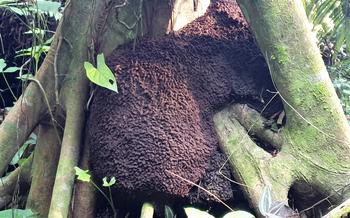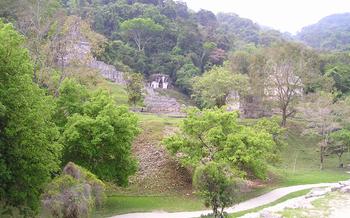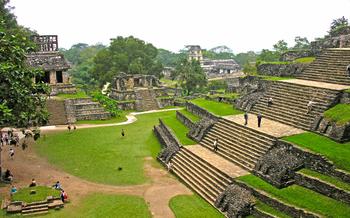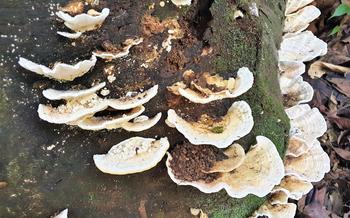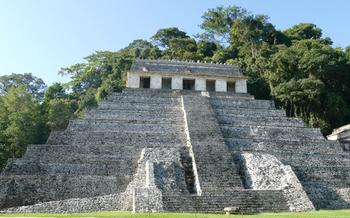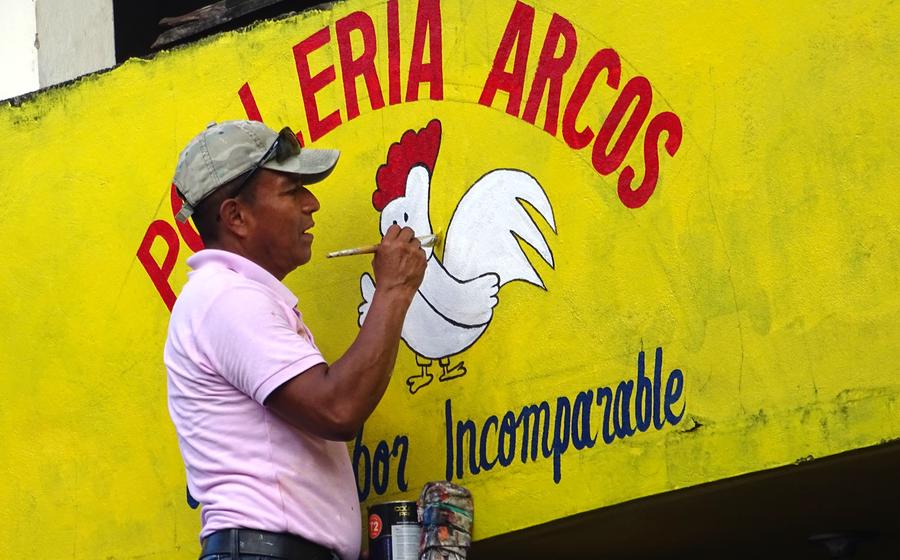
Plaza de la Cruz Foliada
- Plaza de la Cruz Foliada: A Mayan Architectural Masterpiece
- Discovering the Intriguing History of Palenque
- Unveiling the Symbolism of the Plaza
- Exploring the Architectural Wonders of the Plaza
- Delving into the Temple of the Foliated Cross
- Appreciating the Exquisite Relief Carvings
- Unraveling the Mysteries of the Hieroglyphic Inscriptions
- Exploring the Surrounding Archaeological Zone
- Immerse Yourself in the Enchanting Natural Surroundings
- Engage with Local Indigenous Communities
- Plan Your Visit: Essential Tips
- Safety and Precautionary Measures
- Capture the Essence of Palenque Through Art and Photography
- Insider Tip: Discovering Hidden Gems
Plaza de la Cruz Foliada: A Mayan Architectural Masterpiece
In the heart of Palenque's archaeological zone, nestled amidst towering trees and lush vegetation, lies the Plaza de la Cruz Foliada, a testament to the ingenuity and artistry of the ancient Maya. This sacred plaza, named after the intricately carved stone cross at its center, served as a ceremonial and religious hub for the city's inhabitants. Its impressive structures, adorned with elaborate carvings and hieroglyphic inscriptions, offer a glimpse into the rich cultural and spiritual heritage of the Maya civilization.
As you step into the plaza, the grandeur of the Temple of the Foliated Cross, its towering silhouette piercing the jungle canopy, immediately captures your attention. This magnificent temple, dedicated to the Mayan patron deity K'uk'ulkan, showcases exquisite architectural features such as a corbelled arch, intricate roof comb, and a series of interior chambers that once housed sacred artifacts and murals. Its symbolic significance as a place of worship and pilgrimage adds to the awe-inspiring aura of this sacred space.
Beyond the temple's imposing presence, the plaza unfolds with a series of interconnected structures, each playing a distinct role in the religious and political life of Palenque. The Palace, once the residence of the city's rulers, stands as a testament to Mayan craftsmanship, with its intricately carved facades, vast courtyards, and a labyrinthine network of rooms. The Temple of the Sun, with its circular design and intriguing astronomical associations, adds another layer of intrigue to the plaza's sacred landscape.
The Plaza de la Cruz Foliada is not merely an archaeological site but a living testament to the Maya civilization's enduring legacy. Its well-preserved structures, intricate carvings, and rich symbolism invite you to step back in time and experience the grandeur of a once-thriving metropolis. Prepare to be captivated by the beauty, artistry, and profound spiritual significance of this sacred plaza, a true masterpiece of Mayan architecture.
Discovering the Intriguing History of Palenque
Palenque, an ancient Mayan city nestled in the heart of Mexico's Chiapas region, boasts a rich and fascinating history that has captivated archaeologists, historians, and travelers alike. Once a powerful city-state, Palenque reached its peak during the Classic period of Maya civilization, between 250 CE and 900 CE. It was during this time that the city flourished under the rule of a series of prominent rulers, including K'inich Janaab' Pakal I and his son K'inich Kan B'alam II.
Pakal I, also known as Pacal the Great, ascended to the throne in 615 CE and reigned for over 68 years, leaving an indelible mark on Palenque's history. He oversaw a period of unprecedented growth and prosperity, during which the city expanded its political influence and constructed many of the magnificent structures that stand today. Pakal's reign also marked a golden age of artistic and intellectual achievement, as evidenced by the exquisite sculptures, hieroglyphic inscriptions, and architectural marvels that adorn Palenque.
K'inich Kan B'alam II, Pakal's successor, continued his father's legacy and further cemented Palenque's position as a major power in the Mayan world. He led successful military campaigns, expanded trade routes, and commissioned the construction of additional temples and palaces, including the Temple of the Inscriptions, which contains Pakal's elaborate tomb and hieroglyphic inscriptions that provide valuable insights into Palenque's history and culture.
Palenque's downfall, like that of many other Mayan cities, remains shrouded in mystery. However, archaeological evidence suggests that the city faced a combination of factors, including environmental challenges, political instability, and internal conflicts, which ultimately led to its decline and eventual abandonment around 900 CE.
The ruins of Palenque, with its towering temples, intricate carvings, and enigmatic inscriptions, stand as a testament to the ingenuity, artistry, and cultural achievements of the ancient Maya civilization. As visitors explore the Plaza de la Cruz Foliada and the surrounding archaeological zone, they are transported back in time, gaining a glimpse into the lives, beliefs, and accomplishments of this extraordinary civilization that once thrived in the lush rainforests of Chiapas.
Unveiling the Symbolism of the Plaza
The name Plaza de la Cruz Foliada holds deep significance within the Mayan worldview. The term "foliated cross" refers to the sacred symbol of the foliated cross, which represents the tree of life and the four cardinal directions. This symbol is a prominent motif throughout Mayan art and architecture, and its presence in the plaza's name underscores its importance.
The plaza's layout and structures are also imbued with symbolic meaning. The plaza's central location and symmetry reflect the Mayan belief in balance and harmony. The buildings surrounding the plaza, including the Temple of the Foliated Cross, are aligned with the cardinal directions, further emphasizing the connection between the plaza and the Mayan cosmos.
The iconography and motifs found on the plaza's structures and artifacts provide further insights into its symbolism. Depictions of deities, rulers, and mythical creatures adorn the walls and panels of the buildings, each carrying symbolic significance related to Mayan mythology, history, and religious beliefs. The plaza was not merely a physical space but a sacred realm where rituals, ceremonies, and performances took place, connecting the physical world with the spiritual realm.
Exploring the Architectural Wonders of the Plaza
The Plaza de la Cruz Foliada showcases an array of architectural marvels that reflect the ingenuity and artistry of the ancient Mayans. The most prominent structure is the Temple of the Foliated Cross, named after the intricate carvings that adorn its façade. This temple, also known as Temple XIII, is a testament to the Mayans' religious devotion and architectural prowess. Its pyramid-like structure, with its steep steps and imposing height, dominates the plaza.
Other notable structures surrounding the plaza include the Palace, the Temple of the Sun, and various residential and administrative buildings. The Palace, a complex of interconnected rooms and courtyards, served as the residence of Palenque's rulers and their families. The Temple of the Sun, located across from the Temple of the Foliated Cross, is dedicated to the Mayan sun god, Kinich Ahau. Its circular design and elaborate carvings set it apart from the other structures in the plaza.
The architectural style of the plaza is characterized by its use of corbelled arches, which allowed the Mayans to create large, open spaces without the use of columns or beams. The buildings are adorned with intricate stucco reliefs, depicting scenes from Mayan mythology, history, and everyday life. These reliefs provide valuable insights into the culture and beliefs of the ancient Maya.
Comparing the Plaza de la Cruz Foliada to other significant Mayan architectural sites, such as Tikal and Chichén Itzá, reveals both similarities and differences. While all three sites showcase the Mayans' architectural prowess, the Plaza de la Cruz Foliada stands out for its unique layout, the intricate carvings on the Temple of the Foliated Cross, and its relatively smaller size, which gives it a more intimate feel.
Delving into the Temple of the Foliated Cross
The Temple of the Foliated Cross stands as the centerpiece of the Plaza de la Cruz Foliada, a testament to the architectural prowess of the ancient Mayans. Its imposing structure, intricate carvings, and unique features invite visitors to explore the depths of Mayan religious and political life.
The temple's design is a marvel of engineering. Built atop a stepped pyramid, the temple features a single chamber with a corbelled arch ceiling, an architectural technique that allowed the Mayans to create vast interior spaces without the use of support columns. The interior walls are adorned with intricate stucco reliefs, depicting scenes from Mayan mythology and history.
Of particular note is the temple's sanctuary, which houses a large stone altar and a carved stone panel depicting a Mayan ruler seated on a throne, surrounded by attendants. This panel is believed to represent the ruler K'inich Janaab' Pakal, who commissioned the construction of the temple.
The Temple of the Foliated Cross served as a sacred place for the ancient Mayans. It was here that they performed religious rituals, offered sacrifices to their gods, and sought guidance from their spiritual leaders. The temple's elevated position and elaborate decoration suggest that it was reserved for the elite members of Mayan society, including the rulers and priests.
Archaeological discoveries within the temple have shed light on its significance. In 1952, Mexican archaeologist Alberto Ruz Lhuillier discovered the intact tomb of Pakal beneath the temple floor. The tomb contained a wealth of artifacts, including a jade death mask, a carved stone sarcophagus, and a variety of ceramic vessels. These findings provided valuable insights into Mayan burial practices and the importance of Pakal's reign.
Today, the Temple of the Foliated Cross stands as a symbol of the cultural and religious legacy of the ancient Mayans. Its grandeur and beauty continue to inspire awe in visitors, offering a glimpse into the complex and fascinating world of this ancient civilization.
Appreciating the Exquisite Relief Carvings
The Temple of the Foliated Cross boasts intricate relief carvings that are considered masterpieces of Mayan art. These carvings adorn the temple's panels and depict various figures, symbols, and scenes from Mayan mythology.
The panels showcase the exceptional skill and artistry of Mayan craftsmen. The carvings are incredibly detailed and depict a wide range of subjects, including gods, rulers, rituals, and everyday life. Each panel tells a story, providing valuable insights into Mayan culture and beliefs.
The most striking feature of the carvings is their intricate foliated cross design. The cross is a sacred symbol in Mayan culture and is often associated with the World Tree, which represents the connection between the underworld, the human world, and the heavens.
The carvings also depict various animals, such as jaguars, monkeys, and birds. These animals held special significance in Mayan culture and were often associated with specific deities or supernatural beings.
By studying the relief carvings, visitors can gain a deeper understanding of Mayan iconography and symbolism. These carvings are a testament to the rich artistic heritage of the ancient Mayans and continue to inspire and fascinate visitors to this day.
Unraveling the Mysteries of the Hieroglyphic Inscriptions
The Plaza de la Cruz Foliada is not only an architectural marvel but also a treasure trove of ancient inscriptions that hold valuable insights into Mayan history and culture. The Mayans developed a sophisticated writing system consisting of logographic and syllabic glyphs, allowing them to record their language, history, and religious beliefs.
At the plaza, visitors can find numerous hieroglyphic inscriptions etched onto stone tablets and panels. These inscriptions cover a wide range of topics, including historical events, genealogical records, astronomical observations, and religious rituals. The most notable inscriptions are found on the Temple of the Foliated Cross, which features intricate carvings depicting Mayan rulers and deities, along with detailed accounts of their accomplishments and lineage.
Deciphering these inscriptions has been a challenging task for scholars, but significant progress has been made in recent decades. Through careful study and collaboration, researchers have been able to translate many of the glyphs, shedding light on the lives, beliefs, and political structures of the ancient Maya. These inscriptions provide a direct window into the minds and hearts of a civilization that vanished centuries ago, offering us a glimpse into their complex and fascinating world.
Exploring the Surrounding Archaeological Zone
The Plaza de la Cruz Foliada is not the only remarkable structure within the archaeological zone of Palenque. As you explore further, you'll encounter other significant buildings that offer valuable insights into the city's past.
-
The Palace: This sprawling complex was the administrative and residential center of Palenque's rulers. Admire its intricate carvings, courtyards, and galleries, which showcase the Mayans' architectural prowess.
-
The Temple of the Sun: Dedicated to the Mayan sun god, this temple features a towering pyramid base with a series of chambers and passageways. Climb to the top for breathtaking views of the surrounding jungle and the plaza below.
-
Other Notable Buildings: Explore the various temples, palaces, and residential structures scattered throughout the archaeological zone. Each building holds unique stories and architectural features, contributing to the overall narrative of Palenque's history and culture.
Understanding the interconnections between these structures and the plaza provides a comprehensive perspective on Palenque's urban layout and the significant role it played in the ancient Mayan civilization.
Immerse Yourself in the Enchanting Natural Surroundings
The Plaza de la Cruz Foliada is not just a historical and cultural site; it's also a place of breathtaking natural beauty. The archaeological zone is nestled within a lush tropical rainforest, teeming with diverse flora and fauna. As you explore the plaza, take a moment to appreciate the towering trees, vibrant flowers, and exotic birds that call this place home.
The ancient Mayans revered nature and believed in a deep connection with the natural world. The lush vegetation surrounding the plaza was an integral part of their daily lives, providing food, medicine, and spiritual sustenance. As you wander through the site, you'll notice how the structures blend seamlessly with the surrounding environment, creating a harmonious balance between human creation and the natural world.
If you're a nature enthusiast, consider taking a guided tour that focuses on the local flora and fauna. You'll learn about the medicinal properties of plants, the unique adaptations of animals, and the importance of preserving this delicate ecosystem.
Remember to practice responsible tourism by staying on designated trails, avoiding disturbing wildlife, and leaving no trace of your visit. Embrace the opportunity to connect with nature and gain a deeper understanding of the ancient Mayan worldview.
Engage with Local Indigenous Communities
When visiting Palenque, it is essential to remember that the region is home to vibrant indigenous communities who continue to uphold their rich traditions and culture. Engaging with these communities offers a unique opportunity to gain insights into the living heritage of the Maya.
-
Respect and Support: Approach interactions with local people with respect and understanding. Support their livelihoods by purchasing handmade crafts, tasting traditional cuisine, and visiting local markets.
-
Cultural Exchange: Take the time to learn about Mayan traditions, beliefs, and customs. Engage in conversations with locals, visit community centers, and attend cultural events to foster meaningful exchanges.
-
Ethical Interactions: Be mindful of your behavior and interactions with local people. Respect their privacy, ask permission before taking photographs, and avoid intrusive or disrespectful actions.
-
Local Initiatives: Support community-led initiatives that empower indigenous people and preserve their cultural heritage. Consider volunteering, donating to local organizations, or participating in sustainable tourism programs.
By engaging with local indigenous communities, travelers can contribute to the preservation of Mayan culture while creating lasting connections and memories.
Plan Your Visit: Essential Tips
To make the most of your visit to Palenque and the Plaza de la Cruz Foliada, planning is key. Here are some essential tips to ensure a smooth and enriching experience:
- Best Time to Visit:
-
The ideal time to visit Palenque is during the dry season, from November to April, when the weather is pleasant and there's less chance of rain.
-
Itineraries for Efficient Exploration:
- Plan a full day to explore the Plaza de la Cruz Foliada and the surrounding archaeological zone.
-
Allocate sufficient time to admire the intricate details of the temple carvings and hieroglyphic inscriptions.
-
Photography Tips:
- Bring a wide-angle lens to capture the grandeur of the structures and the surrounding jungle.
- Use a tripod for steady shots, especially in low-light conditions.
-
Experiment with different angles to convey the site's scale and majesty.
-
Attire and Packing:
- Dress comfortably and wear sturdy shoes suitable for walking on uneven surfaces.
- Pack light clothing, a hat, sunscreen, and insect repellent.
-
Bring a camera, binoculars, and a notebook for jotting down observations.
-
Guides and Tours:
- Consider hiring a certified guide to gain deeper insights into the history and symbolism of the site.
-
Guided tours are available in various languages and can be arranged through local tour operators.
-
Transportation Options:
- From Palenque town, take a taxi or a local bus to reach the archaeological zone.
- Renting a car offers flexibility for exploring the area at your own pace.
Safety and Precautionary Measures
When exploring the Plaza de la Cruz Foliada and the surrounding archaeological zone, it's essential to prioritize safety and take necessary precautions. Here are some tips to ensure a safe and enjoyable visit:
- General Safety:
- Always be aware of your surroundings and belongings.
- Respect the cultural and religious significance of the site by dressing appropriately.
- Stay hydrated by carrying water, especially during hot weather.
-
Wear comfortable shoes suitable for walking on uneven surfaces.
-
Exploring the Archaeological Site:
- Follow designated paths and avoid climbing on structures to prevent damage and injury.
- Be mindful of uneven steps, loose rocks, and slippery surfaces.
-
Avoid touching or removing artifacts and relics. Respect the historical integrity of the site.
-
Sun Protection:
-
Palenque's tropical climate can be intense. Wear sunscreen, sunglasses, and a hat to protect yourself from the sun.
-
Wildlife Encounters:
-
The area around Palenque is home to various wildlife, including snakes, spiders, and insects. Be cautious and maintain a safe distance.
-
Emergency Preparedness:
- Keep emergency contact information and local resources handy.
- Be aware of the nearest medical facilities and transportation options in case of an emergency.
Capture the Essence of Palenque Through Art and Photography
Palenque is a treasure trove for photographers, artists, and anyone who appreciates the beauty of ancient civilizations. With its stunning architecture, intricate carvings, and lush natural surroundings, the Plaza de la Cruz Foliada and the surrounding archaeological zone offer endless opportunities for artistic expression.
Whether you're a professional photographer or simply enjoy taking snapshots, make sure to capture the plaza's grandeur and the intricate details of its carvings. Experiment with different angles, lighting conditions, and compositions to convey the site's atmosphere and historical significance.
If you're an artist, let your creativity flow as you sketch, paint, or sculpt scenes inspired by Palenque. The site's rich history, vibrant colors, and intricate patterns provide ample material for artistic interpretation.
Once you've captured the essence of Palenque through your art or photography, consider sharing your creations with the world. Post your photos on social media, submit them to travel or photography magazines, or even create an exhibition to showcase your work. Your artistic expressions can help others appreciate the beauty and significance of this ancient Mayan city.
Insider Tip: Discovering Hidden Gems
Beyond the main attractions of Palenque, there are hidden gems waiting to be discovered by curious explorers. Venture off the beaten path to find secluded corners of the archaeological zone, where you can immerse yourself in the tranquility and beauty of the ancient city. Explore the Temple of the Count, a smaller yet equally impressive structure with intricate carvings. Discover the Aqueduct, an engineering marvel that once supplied water to the city. As you wander, keep an eye out for wildlife; you might spot monkeys swinging through the trees or colorful birds flitting among the ruins. Remember to respect the site's sacredness and tread lightly, leaving no trace of your visit. These hidden gems offer a unique opportunity to connect with the spirit of Palenque and create lasting memories.
